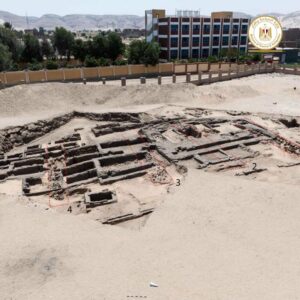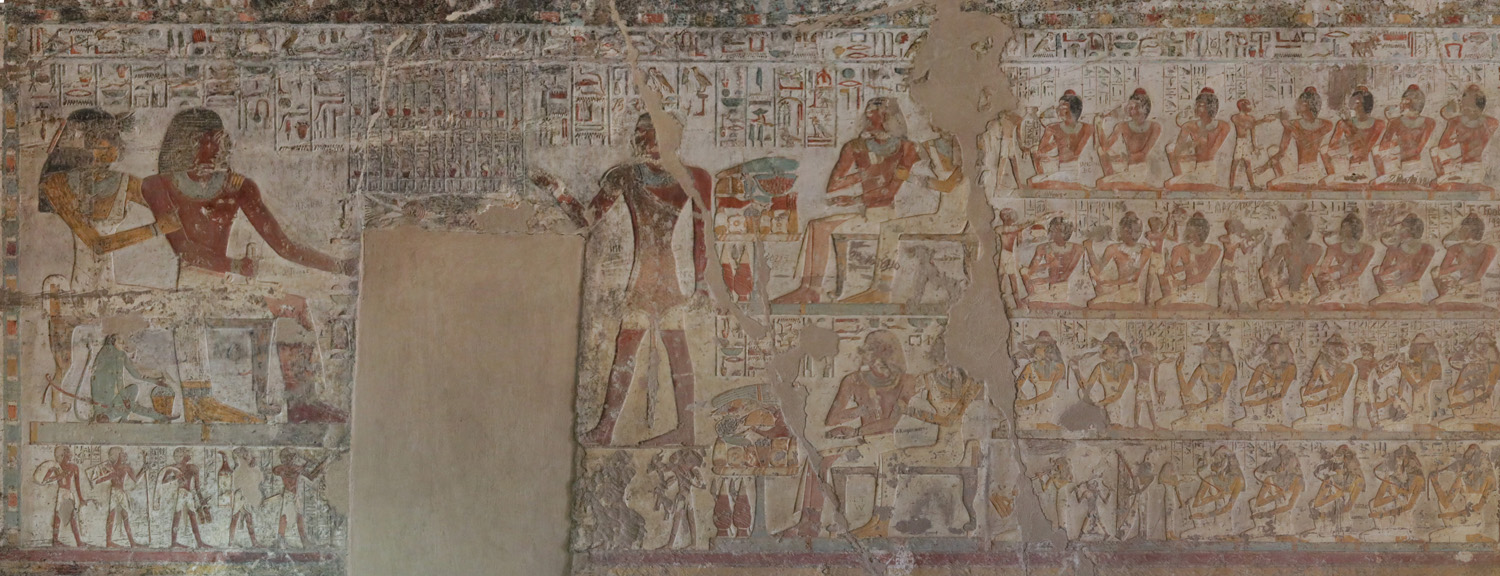-
Lezingen in maart
In maart zijn er weer genoeg online voordrachten te volgen. Deze lezingen worden aangeboden door externe partijen. Indien niet gratis dan worden de kosten vermeld.
Dinsdag 2 maart, 12.00 uur / donderdag 4 maart, 18.00 uur
Dr Okasha El Daly
Egyptology: The missing millennium. Ancient Egypt in Medieval Arabic writings“The Egyptians didn’t care about their pre-Islamic heritage until the Europeans arrived.” Heard this before? In this talk, Dr Okasha El Daly will overturn this long-held misconception by uniting Egyptology and Islamic Studies.
Inschrijven: 2 maart | 4 maart
Dinsdag 2 maart, 20.00 uur
Lara Weiss (Rijksmuseum van Oudheden)
Nieuws uit CaïroVoor zijn grootscheepse vernieuwingsplannen zocht het Egyptisch Museum in Caïro de afgelopen jaren samenwerking met vijf grote Europese musea met Egyptische collecties, waaronder het Rijksmuseum van Oudheden. In deze online lezing vertelt RMO-conservator Lara Weiss over de achtergronden en resultaten van dit bijzondere samenwerkingsproject.
Donderdag 4 maart, 18.00 uur
Rita Lucarelli (Berkeley)
Agents of Punishment and Protection. Assessing the Demonic in First Millennium BCE EgyptDemonology is an integral, though often neglected aspect of ancient Egyptian religion. In this talk, while presenting a current book project, the role that ancient Egyptian demons played in relation to the main deities and to humankind will be outlined, by distinguishing categories of demons according to where they appear, namely demons of the netherworld and demons wandering on earth.
Zondag 7 maart, 19.00 uur
Dr. Ken Griffin (The Egypt Centre)
“All the rekhyt-people adore”Kosten: £5
Egyptian society is often said to have been divided into social classes, with the pat-people representing the ‘elite’ and the rekhyt-people being the ‘commoners’. Yet an examination of the Egyptian texts reveal that the rekhyt-people are commonly described as performing actions, emotions, and gestures for the benefit of the divine pharaoh and the gods. This lecture will examine when and where these actions were performed, and for whom. Additionally, the use and function of the rekhyt rebus will be analysed in detail.
Dinsdag 9 maart, 20.00 uur
Prof. dr. Jacques van der Vliet (Leiden/Nijmegen)
Leidse Papyrologielezing: Moedwil en misverstand op het Egyptische plattelandHet komt maar zelden voor dat papyri licht werpen op leven en werken van bekende historische persoonlijkheden. Zo’n uitzondering is Pisentius, bisschop van Koptos in het zuiden van Egypte. Pisentius wordt tot op de huidige dag als een heilige vereerd in de Koptisch Orthodoxe Kerk. Een rijke literatuur bewaart de herinnering aan de wonderen die hij bij zijn leven verrichtte. Daarnaast is op papyrus een deel van het archief van Pisentius teruggevonden uit de jaren rond 620.
Woensdag 10 maart, 20.00 uur
Manfred Bietak (Austrian Academy of Sciences)
The 14th Dynasty in Avaris/Tell el-Dab‘a and the Looting of EgyptInschrijven via gaelle.chantrain@yale.edu
Donderdag 11 maart, 18.00 uur
Dr Roberta Mazza
Narratives of Discovery: The Finding of the Oxyrhynchus Papyri between Myth and RealityThis talk will consider how the British forefathers of papyrology have disseminated information about their discoveries in Egypt to the public in the late 19th century. It will be shown that when read in the light of more private letters and accounts, these official stories reveal patterns and tropes, while details that we find important today were left out. Were the Oxyrhynchus papyri really discovered by Grenfell and Hunt? This paper argues that they were already well known to the Egyptian inhabitants of the nearby town of el-Bahnasa.
Zondag 14 maart, 16.00 uur
Inês Torres Ph.D.
Lassoing for Offerings or Lassoing for Visitors? Analyzing a Unique Lassoing Scene from the Mastaba of Akhmerutnisut at Giza (G 2184)Kosten: gratis voor donateurs en studenten, €5 voor niet-donateurs
Voertaal: EngelsIn Torres haar lezing neemt ze je mee naar de mastaba van Akhmerutnisut, hetgeen een monumentale afbeelding toont van de grafeigenaar die een touw vasthoudt, klaar om een lasso te werpen. De actieve deelname van de grafeigenaar aan een lasso-scène is uniek in het iconografische programma van elitetombes uit de 5de Dynastie (ca. 2494-2345 v.Chr.). Daarbij analyseert ze Akhmerutnisuts lasso-scène vanuit het analytische kader van monumentaliteit, identiteit en keuzevrijheid (agency).
Zondag 14 maart, 19.00 uur
Dr. Heidi Köpp-Junk
Music in ancient Egypt and its beginnings – Latest research in music archaeology
(lecture including live musical performance)Kosten: £5
This lecture, showing the current research results of ancient Egyptian music archaeology, deals with the origins in Neolithic, Predynastic, and Early Dynastic Times that allowed the development of the complex system as attested in the Old kingdom. Heidi Köpp-Junk shows 5000 years of ancient Egyptian music history with over twenty-five instruments.
Dinsdag 16 maart, 12.00 uur
Nozomu Kawai
Excavating the first Roman catacomb at SaqqaraThe Japanese-Egyptian mission to North Saqqara has excavated at the eastern escarpment at the North Saqqara plateau since 2017. In August 2019, we discovered the first Roman catacomb ever found in Saqqara. The catacomb consists of a long vaulted mudbrick passage to the entrance to the rock-cut chamber and several side rooms. This lecture will present the latest result of the excavation at the Roman catacomb.
Woensdag 17 maart, 20.00 uur
John Rogers (Swansea University)
Of Kings, Courtiers, and CommonersKosten: £3
For many, the image of ancient Egyptian rulership consists of an all-powerful king at the top, with only occasional difficulties when a certain king was weaker than his predecessors. But scratch the surface and the situation is far more complicated. In this talk we will look at the ancient Egyptian king in a local context: ultimately—if the king is not all-powerful—who ran the ancient Egyptian state?
Donderdag 18 maart, 16.00 uur
Dogs in Ancient Egypt
In our last curator’s chat, a request was made for a discussion on ancient Egyptian pets, and with four beautiful greyhounds at home I thought a talk on dogs would be perfect. In this talk we will explore the relationship between humans and dogs in ancient Egypt: dogs as pets, dogs in hunting and dogs in religion. We will also ask the question, was Anubis a dog?
Donderdag 18 maart, 18.00 uur
Sabrina Rampersad
Branding, Non-Literacy, and Bread in Ancient EgyptAs the material culture from the settlement of Tell Gabbara (eastern Delta) undergoes study, the present focus is on its enigmatic potmark corpus. Markings incised deeply onto the interior surfaces of bread moulds have been equated with ancient branding activity, since such marks imprinted the surfaces of bread loaves with single textual signs during the baking process. This presentation will draw from multiple disciplines such as marketing, clinical neuropsychology, and psycholinguistics to illustrate these salient features of potmark-brands in Early Dynastic Egypt.
Zaterdag 20 maart, 15.00 uur
Dr Eleanor Dobson (University of Birmingham)
Whatever happened to Carter’s canary?: Facts, Fictions and Tutankhamun
Kosten: £5
The discovery of the tomb of the pharaoh Tutankhamun in 1922 is one of the best-known archaeological narratives of our age. The uncovering of the pharaoh’s final resting place with its wealth of gilded artefacts was cause for much celebration both in Egypt and abroad. But within weeks of the king’s burial chamber being opened, the man who financed the dig, the fifth Earl of Carnarvon, was dead. Around the world and fuelled by tales of vengeful spirits in the press, people asked: was Carnarvon the victim of the mummy’s curse?
Dinsdag 23 maart, 18.30 uur
Francesco Tiradritti
The Cenotaph of Harwa: a Masterpiece of the Pharaonic RenaissanceThe Italian Archaeological Mission to Luxor and in Sudan works in the Funerary Complex of Harwa (TT 37) and Akhamunru (TT 404) since 1996. With its 4000 square meters of extension the Cenotaph of the Great Majordomo of the God-Wife Harwa (end of the 8th Century BC) is one of the largest monuments ever built by an Egyptian official. The wonderful and fine decoration is inspired to an archaizing style with innovative tendencies that make the cenotaph a masterpiece of the cultural movement known as “25th Dynasty Renaissance”.
Dinsdag 23 maart, 19.00 uur
Dr Anna Garnett
From the Nile Valley to Camden: A History of the Petrie MuseumThe Petrie Museum, based in Malet Place and part of University College London, is home to over 80,000 objects from Egypt and Sudan, and many of these objects were excavated by Sir William Matthew Flinders Petrie and his Egyptian workforces from sites across Egypt.
This illustrated talk by the museum’s curator, Dr Anna Garnett, will explore some of the lesser-known stories relating to the collection, particularly focusing on how and why the collection came to be in Camden, and some of the characters who contributed to the foundation and care of the Petrie Museum over the past century.
Zondag 28 maart, 14.00 uur
Lara Weiss (conservator Egypte, RMO)
De kapel van PaätenemhebPaätenemheb was koninklijk schenker aan het hof van Toetanchamon, rond 1300 v.Chr. Zijn grafkapel stond ooit bovenop zijn ondergrondse grafkamers in Sakkara (Egypte). Ingehuurde priesters, vrienden, collega’s en natuurlijk zijn familie hem konden hem hier offers brengen en hem herdenken. Deze online rondleiding biedt een unieke kans om samen met Lara Weiss naar de mooie details in de kapel van Paätenemheb te kijken: u ziet niet alleen de beroemde harpspeler, maar ook heel veel andere details. Wat staat er allemaal op de muren afgebeeld en waarom?
Woensdag 31 maart, 20.00 uur
Nikos Lazaridis (California State University, Sacramento)
Crafting characters in ancient Egyptian storytellingInschrijven via gaelle.chantrain@yale.edu
-
‘Oudste bierbrouwerij ter wereld’ herontdekt
In Abydos is een bijzondere vondst gedaan. Het Ministerie van Oudheden noemt het de mogelijk oudste bierbrouwerij ter wereld. De brouwerij zou uit de tijd van Narmer stammen, de eerste koning van een verenigd Egypte en dus van de eerste dynastie (ca. 3150 v.Chr.).
Archeologen vonden ruimtes met daarin aardewerken bassins in rijen, waarin graan en water werden verhit om bier te produceren. Door residuanalyse (het bestuderen van resten die zijn achtergebleven in de potten) kan worden nagegaan wat er voor ingrediënten zijn gebruikt. De rijen met vaten wijzen op de industriële omvang van de brouwerij.
In deze vaten werd bier gebrouwen De rijen met vaten wijzen op de industriële omvang van de brouwerij De opgraving in Abydos De vondst is echter niet nieuw maar een herontdekking van een eerdere opgraving uit 1912 door de archeoloog T. Eric Peet. Hij werkte voor de Egypt Exploration Society in het noorden van Abydos. Onder de vroegste tombes in ‘Begraafplaats D’ vond hij een serie oudere structuren, die hij ‘graanovens’ noemde. Hij dateerde de installatie als Laat Predynastisch, maar de volledige omvang en functie bleef toen onbekend.
Bier was belangrijk voor de oude Egyptenaren, niet alleen omdat het dagelijks voedsel was (een minder alcoholische, meer voedzame versie dan ons moderne bier), maar ook omdat het samen met brood een van de belangrijkste offergaven was aan de goden en de overledenen. Er is berekend dat de installatie in Abydos zo’n 22.000 liter bier in een keer zou kunnen produceren. Het is echter niet de oudste brouwerij in Egypte. Ook in de predynastische stad Hierakonpolis werd al bier gebrouwen. Je leest er meer over op de website van deze opgraving.
Abydos is bekend om de impossante tempel van Seti I en de minder bekende tempel van Ramses II, maar ook voor de vroegste farao’s was dit al een belangrijke begraaf- en cultusplaats. De opgraving in Abydos is een samenwerking tussen Matthew Adams van New York University en Deborah Vischak van Princeton University.
Bekijk een filmpje van de opgraving uit 2020 »
Bronnen: Twitter | The Guardian | Abydos.org
-
Lezingen in februari
Zondag 7 februari, 15.00 uur
Prof. Salima Ikram (American University in Cairo)
Divine Protection: Ancient Egyptian Vernacular Shrines in the Eastern SaharaInschrijven via bilkentarkeo@gmail.com
Maandag 8 februari, 18.00 uur
Matthew Cobb (University of Wales)
The port of Berenike and the Red Sea trade in Late AntiquityInschrijven via christian.knoblauch@swansea.ac.uk
Dinsdag 9 februari, 12.00 uur / donderdag 11 februari, 18.00 uur
Dr Nora Shalaby (Humboldt-Universität Berlin)
The Abydos Paper Archive: Exploring Egyptian Histories from Early EgyptologyThe recent discovery of thousands of archival documents in a storeroom inside the Temple of Seti I in Abydos represents a significant and valuable dataset that can contribute to a more holistic history of the discipline that involves actors who have traditionally been sidelined.
Inschrijven: 9 februari | 11 februari
Dinsdag 9 februari, 18.00 uur
Antonio J.Morales (University of Alcalá)
Early Middle Kingdom elite officials and royal strategies at ThebesIn the last four years, the University of Alcalá Expedition and its Middle Kingdom Theban Project have set up a multidisciplinary and international team of experts that have been conducted archaeological excavation, epigraphic work, and conservation in several tombs in the area of Deir el-Bahari, with the major goal of improving our knowledge on the historical circumstances of the later part of the Eleventh Dynasty and the beginning of the so-called “Classical Period”.
Te volgen via Facebook Live
Dinsdag 9 februari, 18.00 uur
Dr. Pavel Onderka (Nationaal Museum Praag)
Bes in Nubia: The Typhonium at Wad Ben NagaZaterdag 13 februari, 18.00 uur
Dr. Campbell Price (Manchester Museum)
Sex, Art, and Death in Greco-Roman EgyptThe exhibition Golden Mummies of Egypt explores multicultural expectations for the afterlife using more than 100 objects from the Manchester Museum’s world-renowned collection. This virtual lecture by Dr. Campbell Price interrogates the functions of the exhibition objects, assessing the impact of the expectations of modern viewers and evaluating the particular seductive attraction of painted portraits and gilded mummies.
Woensdag 17 februari, 18.30 uur
Renée Friedman (Oxford)
Exploring the City of the Falcon: Egypt’s first capital at HierakonpolisHierakonpolis has long been famous as the home of the palette of King Narmer, a potent icon for the birth of Egyptian civilization at ca. 3100 BC. However, ongoing work at the site is now extending back our view of its development by some 500 years. Explorations in the elite cemetery HK6 have revealed tombs of the local rulers, who expressed their power not only in the elaborate architecture and contents of their sizable graves, but also with the people and intriguing array of animals they took with them to the afterlife. Exotic animals, such as elephants, a leopard, troops of baboons and more, attest to a veritable royal menagerie, and give us a tantalizing glimpse at the complex rituals that must have surrounded their burials.
Woensdag 17 februari, 20.00 uur
Dimitry Laboury (Université de Liège)
In the workshop of an Ancient Egyptian sculptor: The estate of the chief royal sculptor Thutmose at Akhet-Aten (Amarna)Inschrijven via gaelle.chantrain@yale.edu
Woensdag 17 februari, 20.30 uur
Emmet Jackson, PhD Candidate (University of Exeter)
Irish Women in Egypt: Travels of Lady Harriet Kavanagh & Frances Power CobbeKosten: £2.50 voor niet-leden
Lady Harriet Kavanagh and Frances Power Cobbe are two of the more notable Irish female travellers to Egypt in the 19th century. Drawing on published and unpublished diaries and their letters from Egypt this talk will introduce the travels and antiquarian collections of these two extraordinary Irish Women.
Donderdag 18 februari, 18.00 uur
Ellie Jones (University of Oxford)
Terms of Gendered Representation: Reassessing the Role of Elite Women in early-mid 18th Dynasty Funerary Iconography from Thebes and El-KabAncient Egyptian tomb iconography has been interpreted with two main functions: successful transition to the afterlife (rebirth) and self-presentation. The funerary portrayals of elite women have primarily been explained through the former function, focusing on how their sexuality and fertility assisted in the rebirth of the (male) tomb owner. This lecture, which summarises the speaker’s DPhil research, takes a wider perspective, exploring the potential meanings encoded in the depiction of female relatives in order to reassess this gendered dichotomy in the interpretation of ancient Egyptian tomb iconography.
Donderdag 18 februari, 19.30 uur
Silvia Štubňová Nigrelli PhD
Life in Ramesside Deir el-Medina: in the footprints of the scribe QenherkhepshefKosten: Gratis voor donateurs en studenten, € 5,- voor niet-donateurs
Voertaal: EngelsDeir el-Medina is een bekende site gelegen op de Thebaanse westoever. Vroeger werd deze site bewoond door de werklieden en ambachtslieden die, tijdens het Nieuwe Rijk, de graven in de Vallei der Koningen en de Vallei der Koninginnen bouwden en versierden. Het dorp heeft Egyptologen voorzien van een unieke reeks materialen en gegevens over de oude bewoners. In deze lezing zullen we kijken hoe het was om in het dorp tijdens de Ramessidentijd te leven door in de voetsporen te treden van een van de bekendste schriftgeleerden van het dorp, Qenherkhepshef.
Zaterdag 20 februari, 14.45 uur
Paul Whelan
The Symbiosis of King and Cult – Abydos in the Old KingdomKosten: £3 voor SAES-leden, £6 for niet-leden
This lecture will look at the ancient cult centre of Abydos during the Old Kingdom, which was one of the most formative periods in its history. Looking primarily from a royal perspective, the available evidence reveals the evolving physical and spiritual landscape at Abydos from the 4th – 6th Dynasties and how the royal presence there changed over this time.
Maandag 22 februari, 18.00 uur
Julien Cooper (UIC Zhuhai)
Desert Politics: State formation in the Egyptian Eastern Desert and the ‘Rise of the Blemmyes’Inschrijven via christian.knoblauch@swansea.ac.uk
Dinsdag 23 februari, 20.00 uur
Dr. René Preys (KUL/UNamur)
Epigrafie in Karnak: de tempel van Amon tijdens de Grieks-Romeinse periodeKosten: €4 voor niet-leden
Tijdens de Grieks-Romeinse periode werd in de tempel van Amon in Karnak vooral gebouwd en gerestaureerd op de as van de tempel. De epigrapfische missies van de UNamur en de KULeuven bestuderen al 10 jaar lang de activiteiten van de Ptolemaeën in Karnak. In deze lezing wordt vooral het werk van de graveurs en de schilders bekeken. Hoe hebben ze de decoratie op de muren aangebracht? Met hoeveel waren ze aan het werk? Hoeveel tijd nam het om een monument te versieren? En hoe kan hun werk ons helpen de monumenten te dateren?
Woensdag 24 februari, 20.00 uur
Aaron de Souza (Austrian Academy of Sciences)
Vile Kush came: New thoughts on Egyptian-Nubian relations at the dawn of the 18th dynastyInschrijven via gaelle.chantrain@yale.edu





